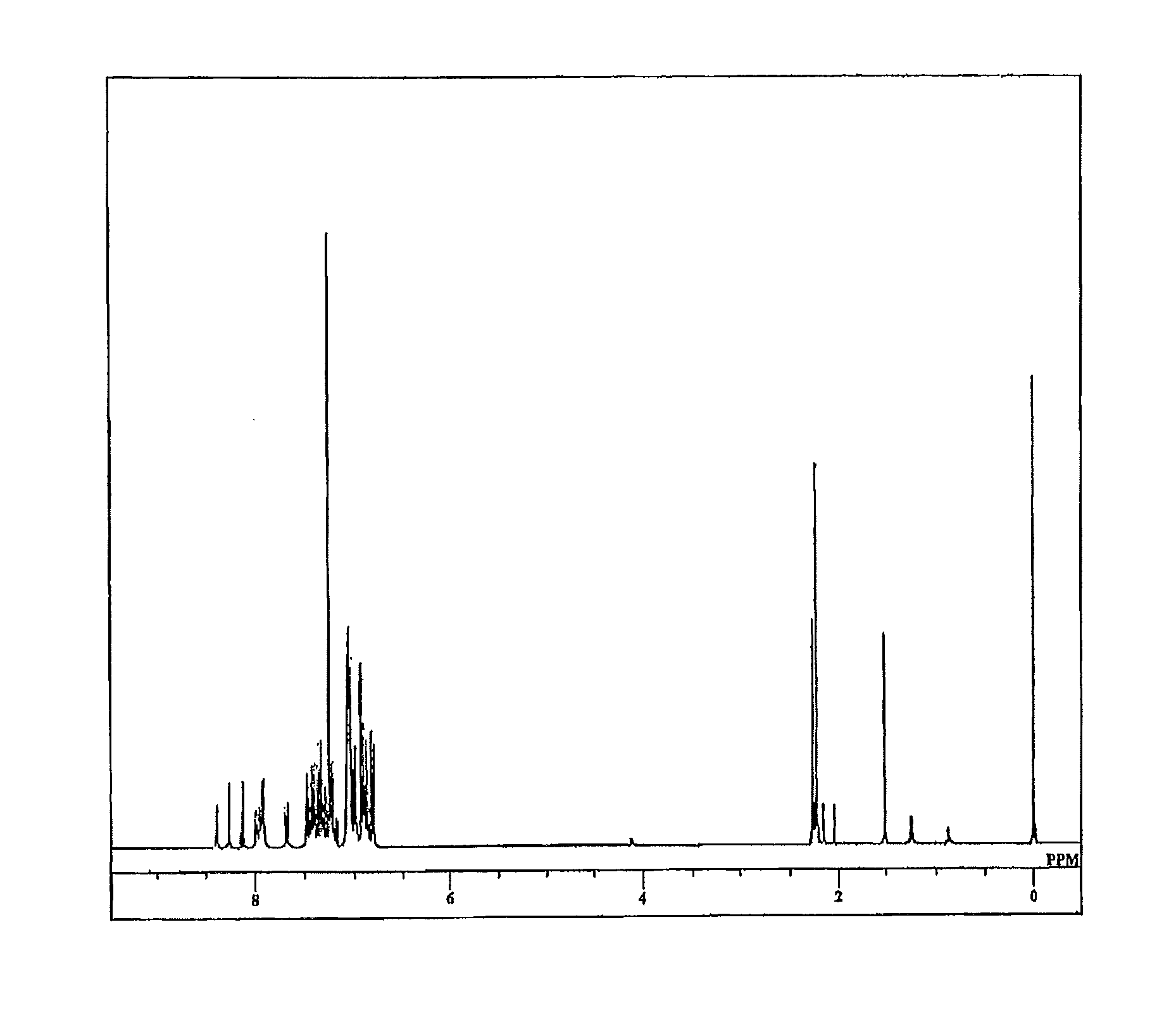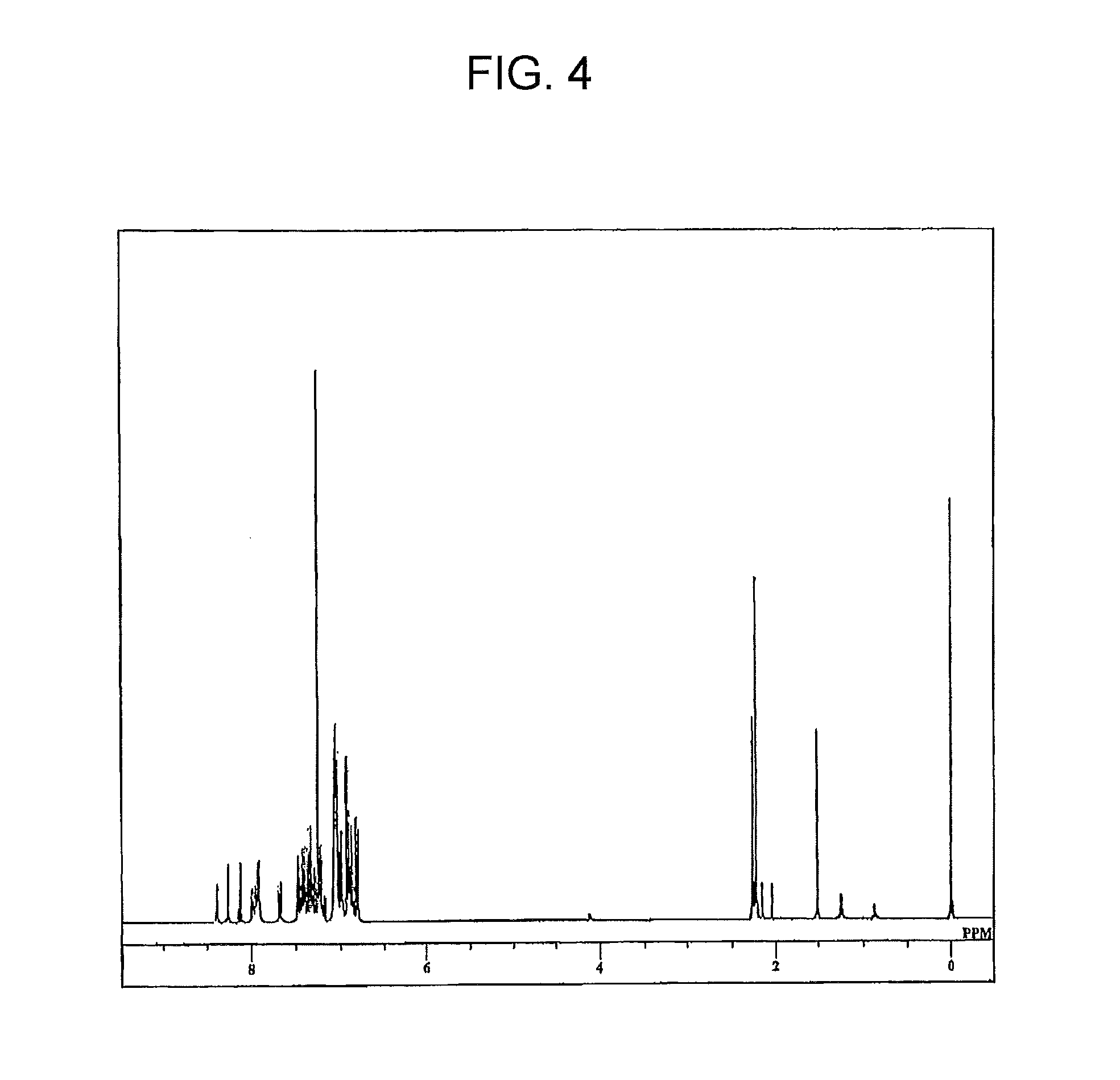Charge transport material that is an ethylene compound, electrophotographic photoreceptor containing the charge transport material, and process for producing the electrophotographic photoreceptor
a technology of charge transport layer and charge transport material, applied in the field of electrophotographic photoreceptors, can solve the problems of limited art for adding specific additives to charge transport layers, limited photoreceptor characteristics and conditions, and few compounds meeting the conditions of practical use of photoreceptors, etc., to achieve the effect of less photodeterioration, reduced light-induced fatigue of photosensitive layers, and reduced residual potential
- Summary
- Abstract
- Description
- Claims
- Application Information
AI Technical Summary
Benefits of technology
Problems solved by technology
Method used
Image
Examples
preparation of example 1
Preparation of Compound I-1
[0108]Step (a): A 2-liter, two-neck flask was charged with Compound 11 below (25.5 g, 0.15 mol), 1-(4-chlorophenyl)ethanone (23.3 g, 0.15 mol), 2-(dicyclohexylphosphino)biphenyl (0.13 g, 0.038 mmol), trisdibenzylidene acetone dipalladium (0.17 g, 0.19 mmol), t-BuONa (15.4 g, 0.16 mol) and 500 mL of o-xylene. The system was then flushed with argon and the flask contents were stirred at 120° C. for 5 hours, following which the system was cooled to room temperature. The organic phase within the reaction mixture was washed three times with ion-exchanged water, following which anhydrous sodium sulfate and activated clay were added to the organic phase, and drying and adsorption treatment carried out. The xylene was then driven off by vacuum distillation. The resulting residue was purified by column chromatography (chloroform / hexane development), giving Compound 12 below as a solid (yield by weight, 37.02 g; percent yield, 86%).
[0109]
[0110]Step (b): A 2-liter fl...
preparation of example 2
[0123]In Step (e) for the ethylene compound (No. I-1) in Preparation Example 1, the reaction of Compound 16 with Compound 12 according to the synthesis method described in Japanese Patent Application Laid-open No. S60-104951 was attempted, but the target product was not obtained.
[0124]Production of Negative-Charging Multi layer Photoreceptors:
working example 1
[0125]A liquid coating was prepared by dissolving and dispersing 5 parts by weight of an alcohol-soluble nylon (CM 8000 (trade name), available from Toray Industries, Inc.) and 5 parts by weight of aminosilane-treated titanium oxide fine particles in 90 parts by weight of methanol. An aluminum cylinder having an outside diameter of 24 mm was used as the conductive substrate. The liquid coating was dip-coated as the undercoat layer onto the outer periphery of the aluminum cylinder, then dried at a temperature of 100° C. for 30 minutes to form an undercoat layer having a film thickness of about 2 μm.
[0126]Next, a slurry was prepared by dissolving 1 part by weight of polyvinyl butyral resin in 98 parts by weight of dichloromethane, and adding thereto 2 parts by weight of α-type titanyl phthalocyanine. Using a disk-type bead mill filled with zirconia beads having a bead diameter of 0.4 μm to a bulk filling fraction based on the vessel volume of 85 v / v %, 5 liters of the slurry was subje...
PUM
| Property | Measurement | Unit |
|---|---|---|
| emission wavelength | aaaaa | aaaaa |
| absorption wavelength | aaaaa | aaaaa |
| temperature | aaaaa | aaaaa |
Abstract
Description
Claims
Application Information
 Login to View More
Login to View More - R&D
- Intellectual Property
- Life Sciences
- Materials
- Tech Scout
- Unparalleled Data Quality
- Higher Quality Content
- 60% Fewer Hallucinations
Browse by: Latest US Patents, China's latest patents, Technical Efficacy Thesaurus, Application Domain, Technology Topic, Popular Technical Reports.
© 2025 PatSnap. All rights reserved.Legal|Privacy policy|Modern Slavery Act Transparency Statement|Sitemap|About US| Contact US: help@patsnap.com



